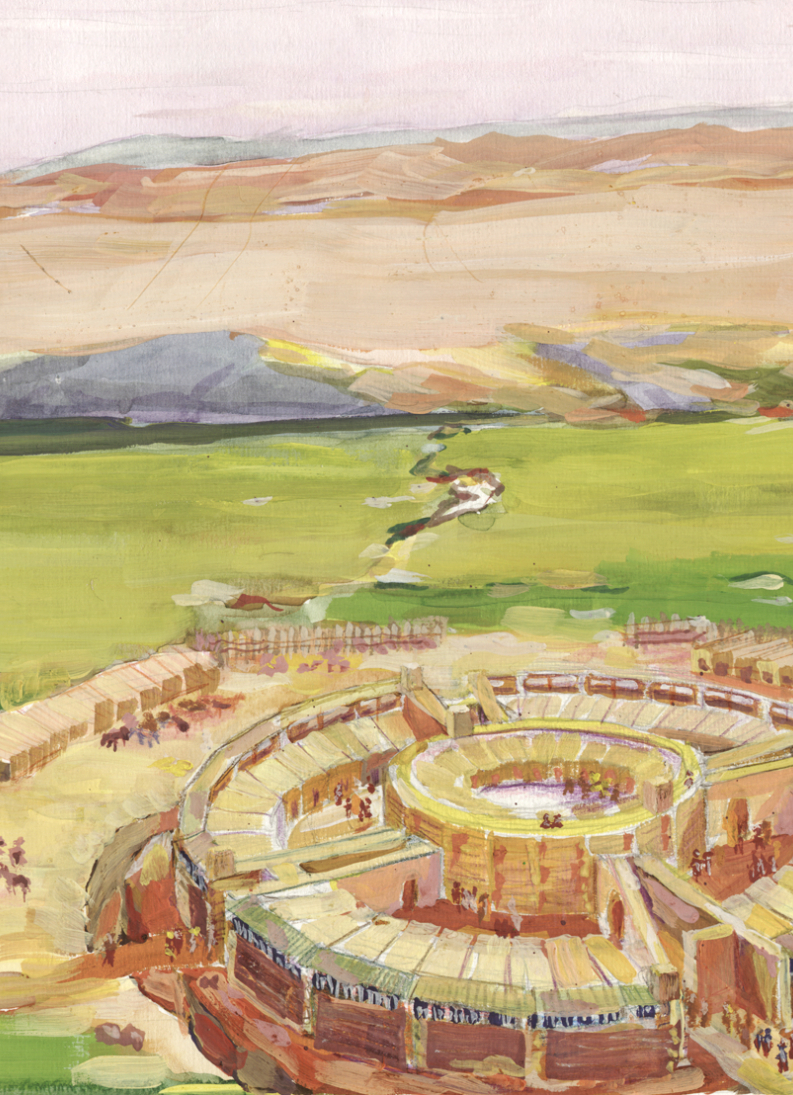Exhibitions
6+Crossroads of the worlds. Arkaim
Kolomenskoe
5 July – 11 September 2022
Ground floor of the Palace of Tsar Alexey Mikhailovich. Building 69, 39 Prospekt Andropova, Kashirskaya metro station
For the first time in Moscow, Kolomenskoe Museum-Reserve presents unique archaeological artifacts from the monuments of the Bronze Age. The most famous among them is Arkaim, that was discovered 35 years ago in the South Ural steppes.
Arkaim is the same age as the English Stonehenge and the Egyptian pyramids. This fortified settlement of the Middle Bronze Age of the XXI-XVII centuries BC was discovered in 1987 by the Chelyabinsk State University archaeological expedition.
The excavations were carried out on the territory intended for flooding during the construction of the Bolshekaragansky reservoir. But thanks to the efforts of the Ural archaeologists and with the support of the State Hermitage Museum director, academician Boris Piotrovsky, and Chairman of the Presidium of the Ural Branch of the USSR Academy of Sciences, academician Gennady Mesyatc, it was decided to preserve the monument. Nowadays, the Arkaim Reserve is one of the most famous places in the Urals.
The Bronze Age, including the ‘Arkaim’ period, largely pointed the directions of human development in the forms we can observe today: technological specializations and innovations, large-scale architectural structures, social transformations, the development of communications, general urbanization and globalization.
The exhibition ‘Arkaim. The Country of Cities’ was displayed with great success in France in 2010-2011 and in Kazan in 2013. In 2022, the Moscow State Integrated Museum-Reserve hosts the archaeological exhibition on its territory. At first glance, there is nothing in common between Arkaim and Kolomenskoe, but this is not the case.
Kolomenskoe Museum-Reserve has one of the largest archaeological collections in Russia. It counts about a hundred thousand museum items; most of them belong to the so-called ‘Dyakovo culture’. Therefore, the exhibition ‘Crossroads of the worlds. Arkaim’ becomes a kind of a “dialogue” between the two cultures.
Another meeting point was a definition as a “place of power” or a place of worship. According to the representatives of the relevant movements, this place has some “special energy”. Such “places of power” often appear after public attention is attracted to them by specialists like archaeologists, ethnographers or historians, who have suggested or established its connection with worship in antiquity. For example, attention to the boulders at the Kolomenskoe Museum-Reserve was attracted by the historian A. S. Chigrin, who worked at the museum as a guide and shared his hypotheses with visitors. Arkaim became a “place of power” thanks to archaeologists who connected it with the Aryans (ancient Iranians).
Excavations of the settlement of Alandskoe. Defensive walls in the process of clearing. 1999
Arkaim settlement. General view. Reconstruction of G. B. Zdanovich. Painted by D. Gubin
Arkaim. Airview of the excavations. The 1990s.
Anthropomorphic sculpture. A random find. Stone
Ornamental ceramic vessel
Excavations of the settlement of Alandskoe. Defensive walls in the process of clearing. 1999
Arkaim settlement. General view. Reconstruction of G. B. Zdanovich. Painted by D. Gubin
Arkaim. Airview of the excavations. The 1990s.
Anthropomorphic sculpture. A random find. Stone
Ornamental ceramic vessel
Excavations of the settlement of Alandskoe. Defensive walls in the process of clearing. 1999
Arkaim settlement. General view. Reconstruction of G. B. Zdanovich. Painted by D. Gubin
Arkaim. Airview of the excavations. The 1990s.
Anthropomorphic sculpture. A random find. Stone
Ornamental ceramic vessel
The main participants of the exhibition are the museums of the Southern Urals. Six museum collections are on display at the Ground floor exhibition hall of the Palace of Tsar Alexey Mikhailovich. The exhibition features 656 exhibits, including the latest archaeological finds, metal, bone, stone, bronze and gold jewelry, ceramic products, anthropological portraits, reconstructions of clothing, and miniatures of dwellings. Visitors can learn about the religious beliefs of the ancient Arkaim, the economic set-up and domestic life, as well as the ancient technologies. The exhibition is complemented by unique documentary materials provided by the State Archive of the Russian Federation, as well as photographs, field journals and archaeological tools. The exhibition also features works by contemporary artists and designers of the Southern Urals, for whom Arkaim has become a source of inspiration.